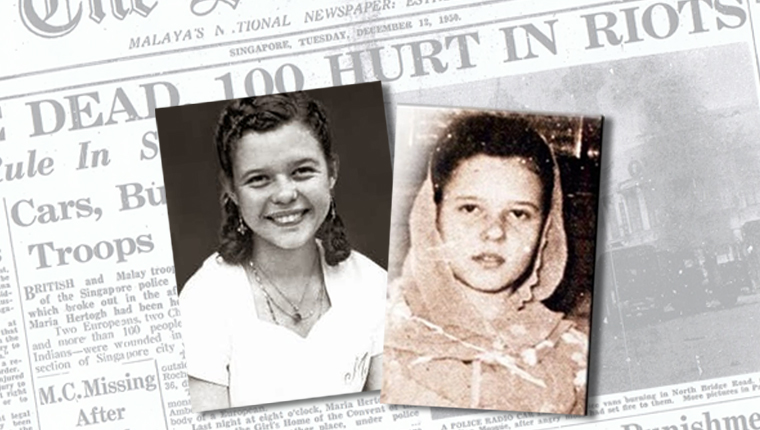The year is 1950.
You are a young Malay man, currently standing outside the Tanjong Pagar Railway station in Singapore, waiting to receive relatives from Trengganu. Two days ago, you received news that a distant aunt Aminah Binte Mohamed and her 13-year-old daughter Nadra are coming down to Singapore urgently to settle some "family issues".
You have not seen Nadra since your last trip to Trengganu but you have a very distinct memory of her Eurasian features and halting Malay. That's because Nadra was adopted by Cik Aminah, your mother told you.
You learnt that Nadra, originally Maria 'Bertha' Hertogh, was born to Dutch-Eurasian parents in Java. After her father was taken as a prisoner of war during the Japanese occupation, Nadra's biological mother gave her up to Cik Aminah. Both Cik Aminah and Nadra moved to Kemaman, Trengganu after the war and never heard from the Hertoghs again.
Cik Aminah and Nadra arrived promptly on the seven o'clock train. You notice their tear-stained faces and wonder what is wrong. Nevertheless, you salaam Cik Aminah dutifully before bringing her and Nadra over to your place.
Once settled in at your home, Cik Aminah started to tell her story. It turns out that after the war ended, the Hertogh family enlisted the help of Dutch officials to help look for Nadra. They searched all over the region and finally found her in Kemaman. Now the Dutch have demanded that Cik Aminah bring Nadra to Singapore where she will be taken back to her biological parents.
"What am I going to do?" Cik Aminah weeps uncontrollably while Nadra hugs her tightly.
Round One: The court ruled in favour of the Dutch
The following week, on 17 May 1950, Cik Aminah and Nadra appear in court.
There was a palpable tension in the air. You glance over at the mother and daughter pair huddled together, and whisper a little prayer for them. Unfortunately, the court ruled in favour of the Dutch. Nadra has to return to the Hertoghs.
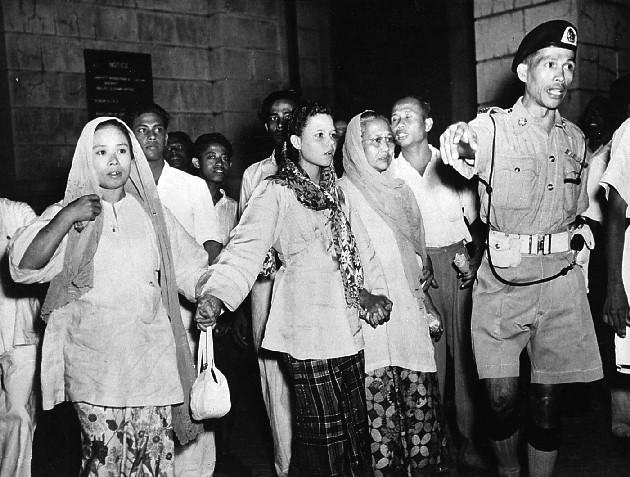 Nadra Ma'arof and Cik Aminah. Source.
Nadra Ma'arof and Cik Aminah. Source.
Cik Aminah is devastated but she is determined to appeal against the court's decision. In the meantime, while waiting for the appeal to be heard, the court orders Nadra to be sent to the Social Welfare quarters at York Hill for safekeeping.
During your calls with Nadra, you learn that a 22-year-old English tutor has been assigned to her at York Hill. His name is Inche Mansoor Adabi and Nadra seems to be enjoying her lessons with him a lot. It has been awhile since you heard laughter in her voice.
Round 2: The court overturns the earlier ruling
Two months later, on 28 July 1950, the court hears Cik Aminah's appeal and overturns the earlier decision. Nadra is now reunited with Cik Aminah. The family and Malay community celebrates with a belated Hari Raya feast at the home of the President of the Muslim Welfare Association.
The atmosphere was electrifying as guests after guests from the community came by and celebrated with Cik Aminah and Nadra. There was abundant music and food -- such a stark difference from her two months at York Hill.
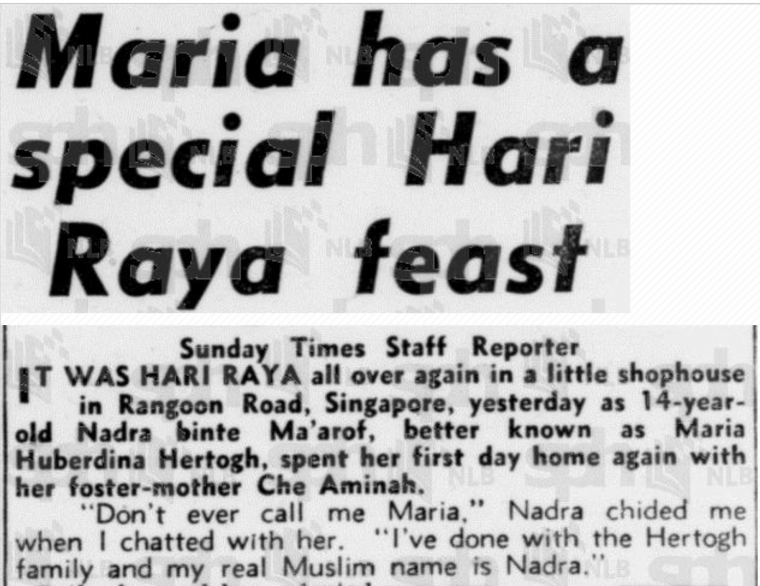 Article from The Straits Times dated 30 July 1950. Source.
Article from The Straits Times dated 30 July 1950. Source.
Marriage
Shortly after Cik Aminah's successful appeal, Nadra announces that she is getting married to her English tutor, Mansoor Adabi. Cik Aminah is overjoyed that she has found a respectable husband.
Privately, you wonder if it is a wise decision to let a 13-year-old girl get married to a 22-year old man. While it is permissible under Muslim laws, some in the Malay community raise concerns about the marriage.
The marriage takes place on August 1, 1950. It is a grand affair since amidst the ongoing court proceedings, Nadra is becoming something of a national celebrity. Reporters from the newspapers are rushing to snap pictures of the newlyweds while loud music entertains guests who came from all over Malaya. Little did everyone know that soon the tides would turn.
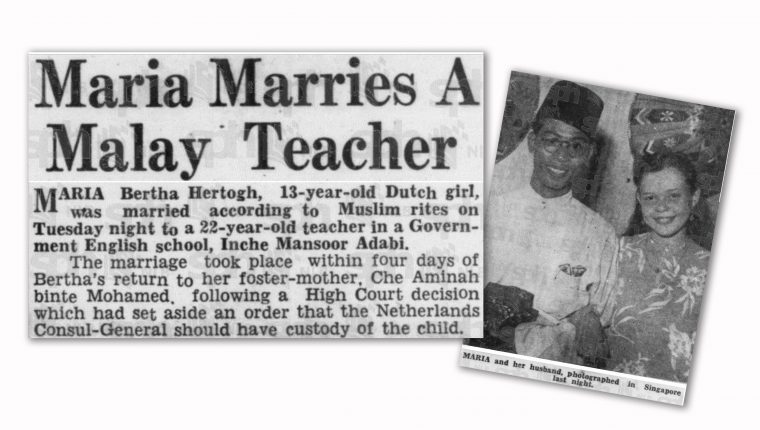 Article and photo from The Straits Times dated 3 August 1950. Source.
Article and photo from The Straits Times dated 3 August 1950. Source.
The beginning of the end
It is now the morning of November 15, 1950. The custody fight for Nadra has been renewed for about a month now. Nadra's biological mother, Adeline Hertogh, comes over for a visit, to convince Nadra to stop the fighting and go home with her.
The tense atmosphere in the living room is punctuated by Nadra's insistent 'No's to Mrs Hertogh's pleadings. Hidden away in the corner of the house, you catch snatches of their exchanges* in Malay:
Mrs Hertogh: "Whatever may be the difficulties, I will stay here and overcome them until I can take you back to your father and brothers and sisters in Holland."
Nadra: "If my parents love me, they should leave me where I am. Besides I cannot love you, because when I was a child you gave me away."
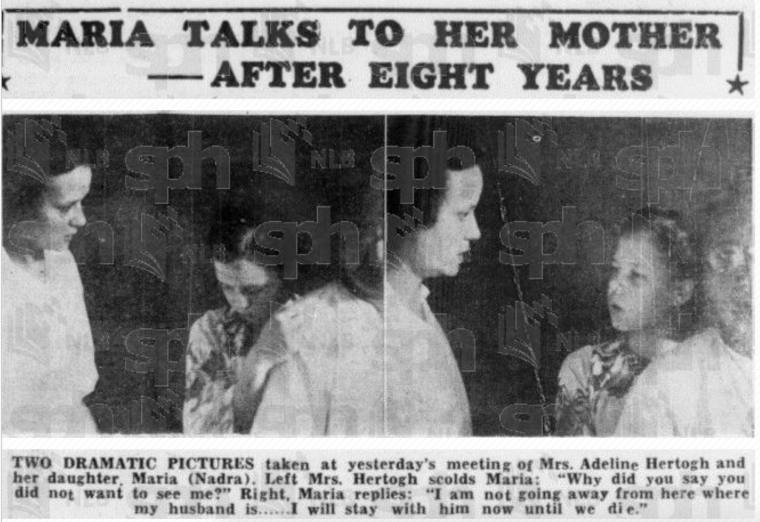 The Straits Times headline dated 16 November 1950. Source.
The Straits Times headline dated 16 November 1950. Source.
The final verdict
Fast forward to two weeks later, December 2, 1950. The court rules in Adeline Hertogh's favour - that the marriage between Nadra and Mansoor Adabi is not legal, and Nadra is to be given back to the Dutch. Cik Aminah applies for a stay of execution to be heard on December 11, 1950.
Before leaving the court, you spot Cik Aminah and Nadra clutching at each other, crying loudly and refusing to leave. Your heart breaks for them. Nadra is then transported to the Convent of the Good Shepherd and placed under the care of Catholic nuns.
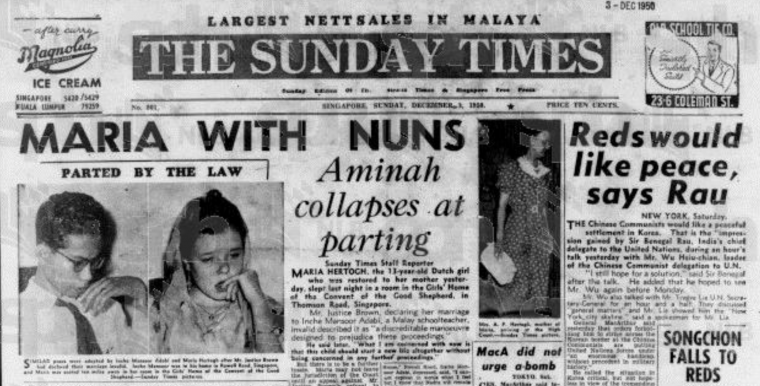 Headings from The Straits Times dated 3 December 1950. Source.
Headings from The Straits Times dated 3 December 1950. Source.
The girl with two faces
The newspapers sensationalise the situation.
The Singapore Standard publishes the headlines "Bertha knelt before Virgin Mary Statue" while Melayu Raya publishes a picture of Nadra caught between a mosque and a church. The Utusan Melayu runs pictures of a miserable Nadra with the headline "I am very miserable – forced to wear a gown" while The Straits Times publishes photos of a smiling and happy Nadra posing with Catholic nuns. Which is the real her?
You notice that many members of the Muslim community also feel that by nullifying Nadra's marriage to Mansoor Adabi and separating the couple, the court was not respecting the religious laws that Muslims abide by.
The tension snaps
By December 11, 1950, crowds of demonstrators gather outside the Supreme Court to demand the release of Nadra back to Cik Aminah. The situation quickly deteriorates into a bloodbath. As you scramble to run out of the way, you hear Eurasians and Europeans alike being stoned and beaten by the angry mobs.
From December 11, 1950 to 13 December 13, 1950, 18 people died, 173 people were injured, and damages to property amounted to more than 20,000 Straits Dollars.
Nadra was relocated to St John's island during the riots, and subsequently taken back to the Netherlands. You never saw her again, just the carnage left behind in her wake.
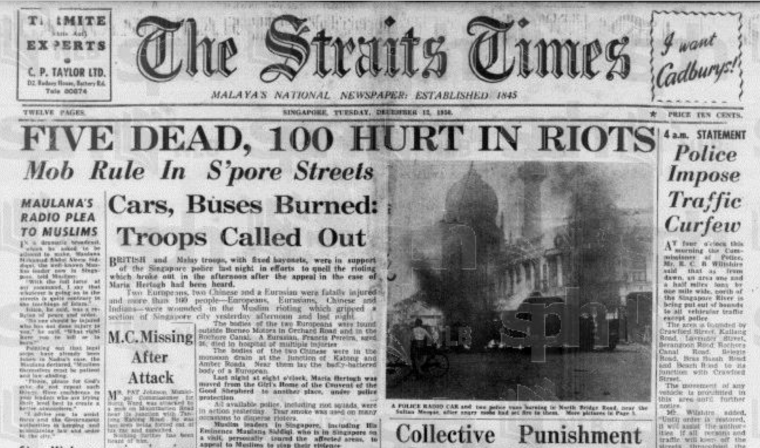 Headlines from The Straits Times dated 12 December 1950. Source.
Headlines from The Straits Times dated 12 December 1950. Source.
A cautionary tale
In retrospect, there are many lessons to learn from Nadra's story, but perhaps most of all, it serves as a cautionary tale about the dangers of religious disharmony, particularly in a religiously diverse place like Singapore.
Mutual understanding and accommodation of different religious beliefs can only happen when we educate ourselves and appreciate the intricacies of different religions. This is the goal of the Harmony in Diversity Gallery (HDG).
Harmony in Diversity Gallery (HDG)
Set up by the Ministry of Home Affairs (MHA) in collaboration with community partners such as the Inter Religious Organisation, the HDG was opened on August 2 2016 as a key feature of the SGSecure movement.
It consists of four thematic galleries which aim to present a cohesive and broad understanding of the different religions here and how we can exercise mutual understanding when differences in beliefs create friction.
Visitors will witness unique religious artefacts from various religions in Singapore, as well as the commonalities in religious expression such as prayer, meditation, and fasting.
While understanding different religions is important, the real test comes when friction from conflicting values creep up in our daily interactions with each other. At the HDG, visitors can explore an interactive exhibit which demonstrates how our decisions can either build bridges that connect or walls that divide.
The HDG is located at the Ministry of National Development Building, Annexe B. Open from Mondays to Saturdays (except Public Holidays) from 10am to 5pm, admission is free. Visit here for more information.
Nadra's story is available at the following links:
-Infopedia entry on Maria Hertogh.
-Infopedia entry on the Maria Hertogh riots.
-NewspaperSG for archived newspapers
If you like what you read, follow us on Facebook and Twitter to get the latest updates.
If you like what you read, follow us on Facebook, Instagram, Twitter and Telegram to get the latest updates.
